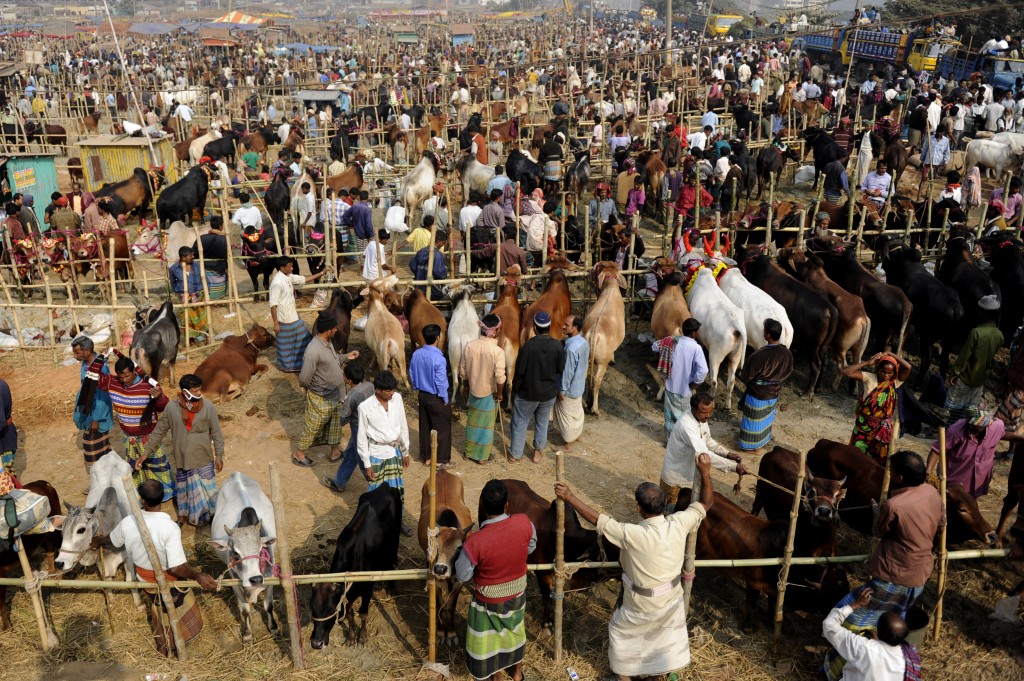Crowd reporting puts the squeeze on traditional journalism

Photo: Munir Uz Zaman/AFP/Getty Images
Critics of using social media to crowdsource news argue that people on the street aren’t objective and that their impressions of an event can’t be trusted. But in this guest blog post for onMedia, journalist Ranty Islam argues crowdsourcing is a key journalism tool that stems from a tradition older than the media itself – the bustling marketplaces and squares that have been used for information exchange since time immemorial.
There’s no truth. Only best guesses. The trend to use social media to crowd verify news is a reminder of how people have always shared and used information. To be useful, facts have to be reliably true enough. And this is the basis of oral traditions which have been around for centuries, if not millenia, in every culture. It’s also the basic operating principle of crowdsourced news verification. Both tap into a collective memory that surrounds any time and place where people are present to witness an occurrence.
So when news agency Storyful polls its network via social media about the veracity of a YouTube video claiming to document government crimes in the Syrian war, this isn’t too different from medieval town squares where storytellers and bards passed on news collected from battle fields or royal courts far away. Your Storyful dashboard and the square only really differ in the size and speed of the network. This means today there are more checks and balances in place to hopefully lessen the number of false judgments.
When it comes to crowdsourced news verification, a knee-jerk reaction from newsroom veterans often sounds something like this …
“How can you trust the subjective testimony of individuals who may be biased or even actively pursuing an agenda, who do not know how to research or cross-check information and who are not journalists?”
The answer is: you can’t.

Image – (CC) Gavin Llewellyn/Flickr
But instead of asking just a few John Does grinding their own ax, you are able to ask hundreds or even thousands of individuals with the click of a button, you will get many different views. These competing perspectives and variety of biased perceptions will ideally drown each other out. Let’s call this ‘noise’. Because they have all witnessed the same event, however, some sort of common theme will surface. Let’s call this the ‘signal’.
The parallel with telecommunications can be pushed further. To get a better ‘signal’, you need a greater input, larger sampling and more exposure. Similarly, the bigger the crowd, the better are your chances of sniffing out a common thread, i.e. a verified version of an event. (Also take a look at the Verification Handbook that’s just been released by the European Journalism Centre.)
However, there are at least two caveats here. To start with, ‘verified’ does not mean it’s ‘true’. If a piece of news has been crowd verified, it just means there is a higher probability it conveys something that has really happened, and therefore is more likely to be true. It’s a best guess, but not the truth. The second issue is that there may be some systemic distortions. In some places, for instance, particular segments of society are less likely to be Facebook or Twitter power users simply because they don’t have regular internet access, can’t afford a smartphone or are less tech-savvy. If these strata of society additionally hold views that are very different from, let’s say, those of articulate, social media savvy, smart-phone wielding urbanites, we have a problem. Verifying news by just polling Twitter users under these circumstances would introduce a selection bias – when ideally more and different channels need to be used.
If these problems can be kept in check though, there’s no reason to believe crowdsourced news verification is less reliable than traditional journalism. In fact, it may score better. The Arab Spring playing out on the streets of Cairo or the fighting in Syria are examples of how crowd based reporting and verification can break news and provide vital background information before traditional journalism.
On the other hand, traditional journalism has been undoing itself. Its often stated commitment to truth, impartiality, objectivity and professional scrutiny are increasingly difficult to maintain in a world which is becoming faster and more complex by the day and where those who are traditionally reported on, now talk back.
A social media-ted public makes itself heard in a way that can naturally be harnessed by crowd-based reporting. But is also forces traditional journalists to act more transparently. It is much harder to buy into the objectivity of foreign correspondents today once you know they draw on their own mere handful of informants. Even a decade ago, this fact may have gone unnoticed.
And impartiality is at long last revealed for what it is: a fiction. Twenty years ago, the likes of the New York Times and the BBC were unquestioningly trusted as authoritative sources of unbiased information. In the massively interconnected world of today they are mere instances (albeit important ones) of a particular culturally and historically conditioned vantage of the world from North of the Equator and West of Greenwich.
This then, is where crowd based reporting really comes into its own. In contrast to traditional journalism, it puts together its story from those who are living and experiencing it rather than those who are observing it. And in a couple of decades from now, the notion that a few professional, trustworthy institutions can reliably inform people about the world will be viewed as an odd historical aberration – wedged, as it is, between centuries of oral traditions and the 21st century take on the same thing.

Ranty Islam is a digital anthropologist and an editor at DW for Global Ideas, a leading, award winning multimedia program covering climate protection and biodiversity around the world. Follow Ranty on Twitter: @2ranty



